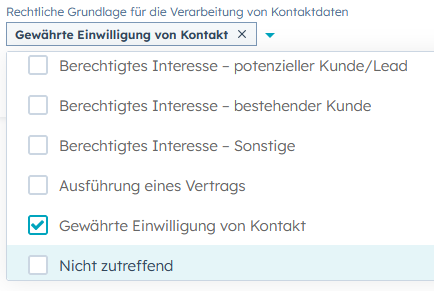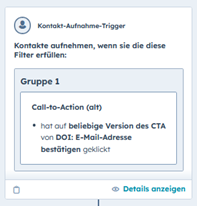"We need to clarify the issue with data protection!" Most people who work in marketing have probably said this sentence at least once. Data protection-compliant work and regular coordination with the data protection department is essential in day-to-day marketing. It is equally important to be able to use your own CRM and the marketing automation software you use in a GDPR-compliant manner. The tools offer various options and functions for this. In this article, we show how HubSpot functions support GDPR-compliant work in marketing.
Legal basis
The provisions of the GDPR state that there must be a legal basis for the use of personal data, for example the consent of a contact. Particularly relevant bases in marketing are the fulfillment of a contract or legitimate interest.
HubSpot distinguishes between two types of legal basis:
- Processing of personal data, e.g. storage of contact data in the CRM
- Communication with contacts, e.g. sending marketing emails
To manage these bases, HubSpot has a standard contact property in which the information can be recorded. The property can be assigned to forms, via an automation or manually. It can also be used to import contact information into HubSpot.
Double opt-in process (DOI process)
HubSpot offers a standard function that can be used to obtain a double opt-in from contacts. This includes a DOI email with customizable text, layout, confirmation page and CTA to confirm the email address. You can also specify which forms and pages should be activated or deactivated for the DOI process. The scope of the functions depends on which HubSpot tariff is used.
In practice, mapping the DOI process with a self-created property and an automated process has proven successful. The advantage is that you have more control over the process itself and the control of the contacts. This type of process is ideal if, for example, you want to use differently worded DOI emails for different content or if you want to assign several properties within the DOI process. It also makes it easier to select the forms to be included in the process.
E-mail subscription types
Subscription types form the legal basis for communication with contacts in HubSpot. These are intended to ensure that no contact receives emails that they do not wish to receive. Contacts have the option of editing these subscription types or unsubscribing completely from any communication. Subscription types can be assigned by obtaining consent from contacts via forms, via an automated workflow or manually by a HubSpot user.
If a contact is now to receive an email, a subscription type must be stored in the email. Only contacts who are registered for this subscription type can receive the email.
Subscription types can be used to map and manage different types of communication in HubSpot, for example marketing and sales communication, career information or information for customers.
Conclusion
These are just some of the functions that HubSpot offers to enable GDPR-compliant marketing. In any case, it is important to coordinate with the data protection officer or the legal department in order to use all functions and processes in HubSpot in a data protection-compliant manner.








